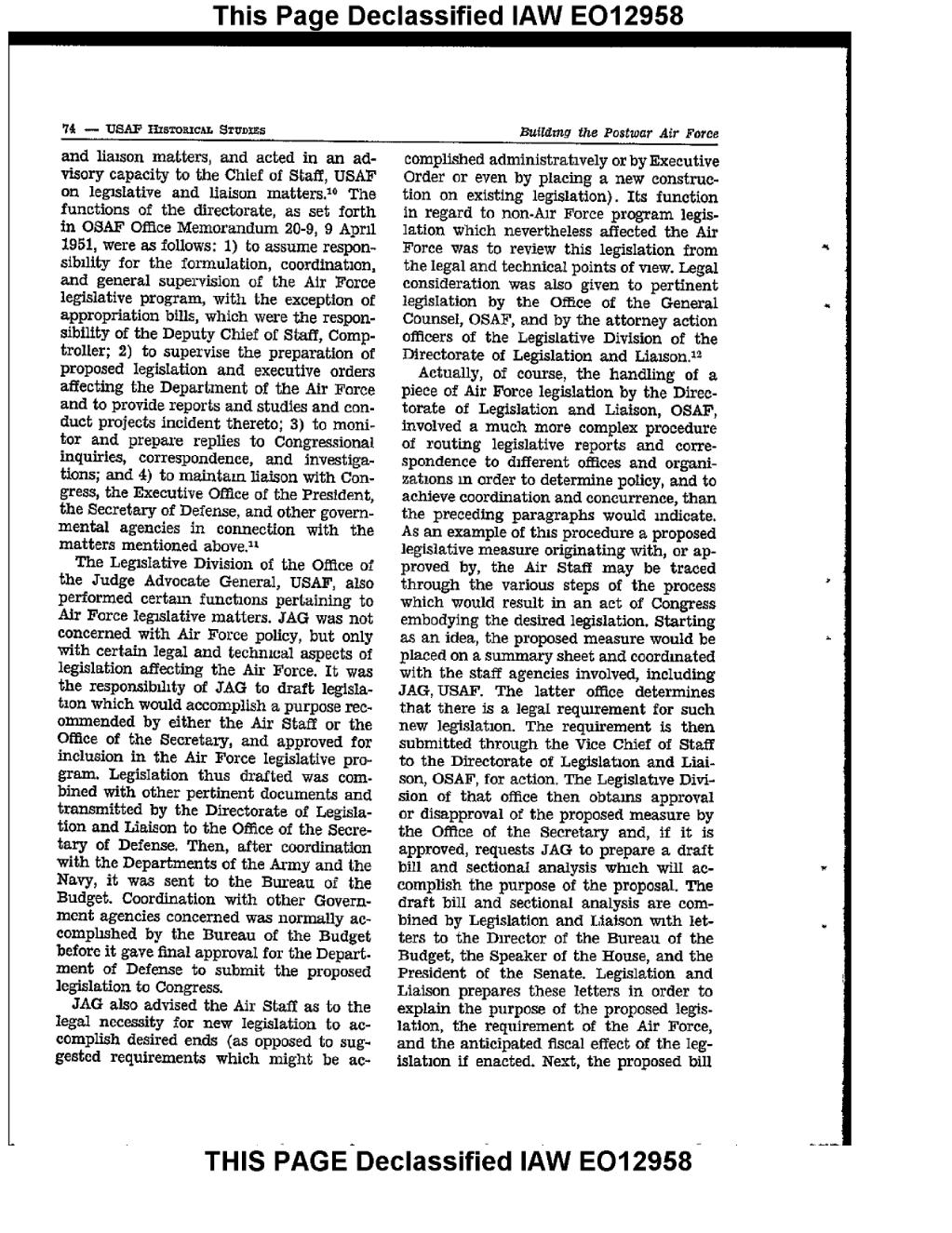�This Page Declassified lAW EO12958 and liaison matters, and acted in an ad- visory capacity to the Chief of Staff, USAF on leguslative and liaison matters. ? The functions of the directorate, as set forth in OSAF Office Memorandum 20-9, 9 Aprfi 1951, were as follows: 1) to assume respon- sibfiity for the iormulation, coordination, and general supervision of the Air Force legislative program, with the exception of appropriation bills, which were the respon- sibility of the Deputy Chief of Staff, Comp- troller; 2) to supervise the preparation of proposed legislation and executive orders affecting the Department of the Air Force and to provide reports and studies and con- duct projects incident thereto; 3) to moni- tor and prepare replies to Congressional inquiries, correspondence, and investiga- tions; and 4) to maintain liaison with Con- gress, the Executive Office of the President, the Secretary of Defense, and other govern- mental agencies in connection with the matters mentioned above. ?* The Legustative Division of the Office of the Judge Advocate General, USAF, also performed certain œunct?ons pertaining to Air Force leguslative matters. JAG was not concerned with Air Force policy, but only with certain legal and techmcal aspects legislation affecting the Air Force. It was the responsibility of JAG to draft legisla- tion which would accomplish a purpose rec~ oremended by either the Air 8taff or the Office of ghe Secretary, and approved for inclusion in the Air Force legislative pro- gram. Legislation thus drafted was com- bined with other pertinent documents and transmitted by the Directorate of Leakslo- tion and Liaison to the Office of the Secre- tary of Defense. Then, after coordination with ?he Departments of the Army and the Navy, it was sent to the Bureau of the Budget. Coordination with other Govern- ment agencies concerned was normally ac- oomphshed by the Bureau of the Budget before it gave final approval for the Depart. merit of Defense to submit the proposed legislation to Congress. JAG also advised the Air Staff as to the legal necessity for new legislation to ac- complish desired ends (as opposed to sug~ geeted requirements which might be complished administratively or by Executive Order or even by placing a new construc- tion on existing legislation). Its ?uncgion in regard to non-A?r Force program legis- lation which nevertheless affected the Air Force was to review this legislation from the legal and technical points of wow. Legal consideration was also given to pertinent legislation by the Office of the General Counsel, OSAF, and by the attorney action officers of the Legislative Division of the Directorate of Legislation and Lia?son.? Actually, of course, the handling of a piece of Air Force legislation by the Direc- torate of Legislation and Liaison, OSAP, involved a much more complex procedure of routing legislative reports and corre- spondence to d?fferent offices and organi- zations m order to determine policy, and to achieve coordination and concurrence, than the preceding paragraphs would indicate. As an example of thin procedure a proposed legislative measure originating with, or ap- proved by, the Air Staff may be traced through the various steps of the process which would result in an act of Congress embodying the desired legislation. Starting as an idea, the proposed measure would be placed on a summary sheet and ccord,nated with the staff agencies involved, including JAG, USAF. The latter office determines that there is a legal reqm?ement for such new legislation. The requirement is then submitted through the Vice Chief of Staff to the Directorate of Legislataon and Liai- son, OSAF, for action. The Legislatxve Divi- sion of that office then obtains approval or disapproval of the proposed measure by the Office of the Secretary and, ff it is approved, requests JAG to prepare a draft bill and sectional analysis winch will ac- complish the purpose of the proposal. The draft bill and sectional analysis are com- bined by Legislation and Liaison vath let- ters to the D?rector of the Bureau of the Budget, the Speaker of the House, and the President of the Senate. Legislation and Liaison prepares these letters in order to explain the purpose of the proposed legis- lation, the requirement of the Air Force, and the anticipated fiscal effect of the leg- islation if enacted. Next, the proposed bin THIS PAGE Declassflied lAW EO12958
